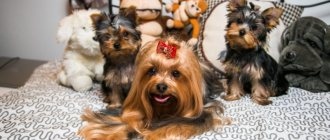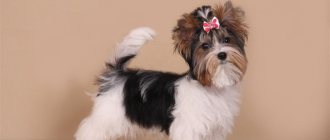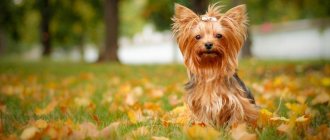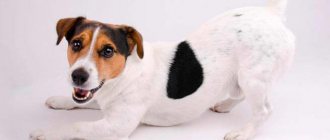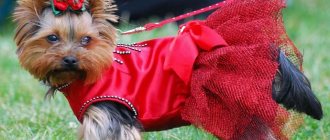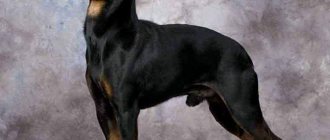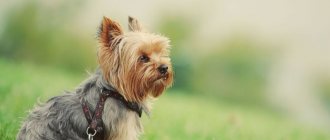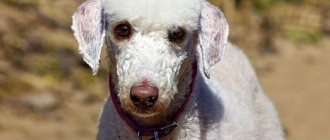Description of the breed
Yorkshire Terriers are small decorative dogs suitable for the home with a long and smooth coat, unique grace and proud bearing.
Exterior of Yorkies in accordance with the breed standard:
- a compact, strong body of a square format with a straight back line, a muscular loin and a short croup with a slope to the base of the tail;
- the chest is oval, the withers are weakly expressed;
- limbs are straight, strong, with well-developed knee and hock joints;
- brushes rounded, claws black;
- the head is small, with a clearly defined transition from the forehead to the short muzzle;
- scissor bite;
- the nose is small, the nostrils are rounded, the lobes are black;
- eyes are small, round, dark;
- the ears are triangular, small, erect, set high;
- the tail is set high, densely covered with as dark hair as possible.
The tail can be natural length or docked.
More details can be found here.
The following are visual photos of girls and boys of this breed.
Distinctive features
These decorative dogs are memorable primarily due to their long coat, which can grow below the tips of the paws, forming a parting from nose to tail . There are mini-Yorks and standard ones based on size. The main criterion is weight; mini pets do not exceed 2 kg, while standard pets can reach 3.2 kg.
The ancestors of this breed were much larger and could gain up to 10 kilograms, this was reflected in modern representatives. Some of them are indeed significantly larger than their counterparts, which is considered a disqualifying defect.
The new standard has been in effect since 2004. It allows tail docking and describes its correctness. Also, according to it, all dogs that do not meet external characteristics are not allowed for further breeding.
- The head is small, the skull is flat. Stop is expressed. The lengths of the head and muzzle are proportional.
- The muzzle is short, straight, rounded towards the nose. Scissor bite, full set of teeth. The incisors are vertical, there is no gap between the fangs. The lips are small, not jagged, well pigmented black.
- The nose is small. Color – only black.
- The eyes are medium in size, set at stop level, round in shape. Not too convex. Color – dark brown.
- The ears are small, set high, but not wide. They stand upright and are covered with thick, straight hair.
- The body is strong, although compact. Straight back, oval ribs. The neck is long. The croup is straight. The withers are well defined. The chest is narrow, of medium depth.
- The tail may be docked or undocked. Cropped to the middle, the hair should remain long. Planted on the spin line, when active it rises higher.
- The limbs are straight with pronounced knee and hock joints. The paws are rounded with strong black claws.
- The coat is long, straight, not wavy. Silky, shiny and smooth, not fluffy or harsh.
- The color is steel or black from withers to tail. On the chest and paws honey silver or warm brown. The muzzle and head are either honey brown or silver brown.
At the moment, only color, coat structure and size are strictly assessed at exhibitions. All deviations from anatomical norms can be “unnoticed” if they do not harm the dog’s health.
There is a type of baby (baby face). It is not included in the standard, but is popular among breeders. Characterized by large eyes and a short muzzle, which gives the pet a cute look.
Origin story
Yorkshire Terriers were bred in the 18th century. in Yorkshire, England.
The appearance of the first representatives of the breed was radically different from modern Yorkies.
But as a result of long and careful selection, the exterior of the dogs was significantly improved.
It is believed that to breed these dogs and improve their qualities, breeders used Manchester terriers, Maltese dogs, as well as Clydesdales and Paisleys that do not exist today.
Yorkshire terriers were recognized as an independent breed in 1886 by the English Kennel Club, and the official standard was adopted 12 years later. The first nursery in Russia was founded in Mytishchi in 1991, 20 years after the first representative of the breed appeared in the country.
Why were they brought out?
The time of the appearance of Yorkies coincided with the introduction in England of a law prohibiting representatives of the lower classes of society from keeping large and medium-sized dogs.
This, as well as the prejudiced attitude towards cats as unclean animals that spread diseases, determined the need for miniature dogs.
The purpose of their breeding is to hunt and destroy rats and other rodents in mines and farms.
However, Yorkies did not remain in this role for long - they were quickly noticed and appreciated by representatives of the upper classes of royal blood and began to be bred at home. Soon dogs took pride of place in salons and boudoirs.
Interesting facts about Yorkshire Terriers
Each creature has many different interesting facts in its history. This is not surprising, because the history of ancestors, pedigree, interesting stories from the life of previous generations of a four-legged pupil will undoubtedly be useful and interesting to the owners of Yorkshire terriers:
- In the large family of Yorkies, the smallest representative, named Sylvia, left her mark. She lived in England and, unfortunately, only lived for two years. The mini-dog's height was 6.3 cm, weight - 112 g.
- Owners of Yorkies who live in suburban areas should pay increased attention to the hunting instincts of their charges. The fact is that while walking through the forest, a dog can catch and eat a beetle or find a wild mouse that an owl has lost. After such “treats”, the dog will in most cases get an upset stomach.
- In the history of breeding miniature Yorkies, there are cases when owners deliberately gave their charges little to eat, and as a result, their growth was inhibited. The goal of these would-be dog owners was to get mini-dogs, but the animals suffered when kept this way. Their psyche was damaged as well as their health. The life expectancy of babies was noticeably reduced.
- Huddersfield Ben is considered a celebrity among the large family of Yorkshire terriers. This dog managed to win 74 prizes in his life, and this dog is considered the “father of the breed.” Unfortunately, his life was short. At the age of 6, he was hit by a crew.
As you can see, Yorkshire Terriers are not just soft, sweet, playful dogs. They require attention; their upbringing, maintenance and feeding have their own nuances that must be taken into account. In this article you will find many tips and recommendations that will help you raise a real well-mannered show Yorkshire terrier from a small Yorkie puppy.
Data on classes and prices
The cost of Yorkshire Terrier puppies varies and depends on the class to which a particular representative of the breed belongs.
Show
Dogs in this class have no disqualifying defects or noticeable significant defects.
These are the owners of an outstanding exterior and excellent temperament.
Which, subject to proper care and good preparation, makes them ideal participants in exhibitions, shows and shows.
The cost of such puppies varies from 15 to 70 thousand rubles. and more.
Breed
The difference between these dogs and the representatives of the show class is in their not so bright exterior. They, like representatives of the show class, have no defects and also have correct anatomy, health and characteristics corresponding to the breed standard. Dogs of the breed class can participate in exhibitions, but they have less chance of winning prizes. Most often, this class includes females participating in breeding. The price for such puppies starts from 15 thousand rubles.
Pet
These are puppies that have disqualifying defects or multiple exterior defects . You can buy them for 5 - 14 thousand rubles. Such dogs cannot be used in breeding work, but as a faithful, devoted and affectionate friend and pet, they are no worse than puppies of other classes.
The class of puppies up to 5 - 9 months can only be determined approximately, so as they develop and grow, the possibility of redistribution cannot be ruled out.
How to choose a puppy, price
- A Yorkshire Terrier can be adopted at any age, starting from 2-3 months. Little puppies are very cute, but they require special care. Many experts recommend taking a “teenager” (6-7 months), when the dog already knows the place for the toilet and its nickname.
- You can buy a Yorkie either in a nursery or from someone else. It is important to ensure that the puppy is healthy and fully complies with the standard. A good breeder will present documents for the dog and tell you about the conditions of its keeping. The correct request would be to look at the puppy’s parents.
- The price depends on the class of the dog and the status of the kennel. Pet-class Yorkies (without pedigree) will cost 5,000-12,000 rubles, breed-class (allowed for breeding) - 15,000-30,000 rubles, and show-class (children of champions intended for exhibitions) - from 30,000 rubles.
Varieties
There is a conditional division of Yorkshire terriers into standard (weight up to 3.1 kg), which is the largest, followed by mini (up to 2.1 kg), super mini (up to 1.5 kg) and baby face, distinguished by a round head shape and a shortened head. muzzle.
Depending on the characteristics of the exterior and coat color, there are varieties of Yorkies:
- biro;
- chocolate;
- goldust;
- black terriers;
- Russian salon;
- mixed breeds - Chorkies, Shorkies, Torques, Yorkies, Morkies, etc.
Separately, it is worth mentioning the Biewer Yorkshire Terriers, which are recognized not as a variety of Yorkies, but as an independent breed.
Read on for more details...
Yorkshire Terrier mini
Mini Yorkies differ from standard ones primarily in their size. Their weight does not exceed 2 kilograms, but they are also considered full representatives of the breed and are not disqualified. There are also super mini Yorkies, their weight varies from 1.3 kg to 1.5 kg.
This variety of terrier is characterized by a softer, calmer and good-natured character . They are not so stubborn, not so cocky, less active and unobtrusive. In addition, their hunting instincts are much weaker than those of standard ones. It is easier to train such pets to the tray. You can take them with you on any trip; thanks to their tiny size, they are easy to transport. The mini's coat is not so long and thick, making it much easier to care for.
The main disadvantage of mini-dogs is their pain . They are much weaker than ordinary terriers and very fragile. A fall from a low sofa can cause irreparable harm to such a pet. Dogs are cowardly, do not tolerate loneliness well, and are often sad. Nutrition for them must be selected more carefully: full compliance with all rules is necessary. Prone to whims.
Mini Yorkies are more expensive than standard ones and are harder to find in kennels. The size does not allow all mini-girls to bear and give birth to puppies.
Photo: Mini Yorkshire Terrier
Dog and children
Yorkshire Terriers get along well with children and establish friendly relationships with them. However, it is better not to get these dogs for families who have a small child under 5 - 7 years old; they, through negligence, can harm the fragile pet during play by accidentally stepping on it or simply hugging it too tightly.
General rules of education and training
Physical punishment of Yorkshire Terriers is prohibited. If you want to show the puppy dissatisfaction with his behavior, it is permissible to splash water on him or sharply clap your hands. In addition to these measures, it is best to scold the puppy in a stern, menacing voice.
A dog can be punished for unwanted actions only at the moment of commission. Raising a Yorkie should be based on the pet's trust in the owner and their mutual understanding, and not on cruelty.
And it’s worth training your pet only when he’s alert and well-fed:
- The Yorkie should not be allowed to take the leading position even for a short time. A person should always dominate.
- You need to praise and reward your pet with treats for success.
- Terrier training should be done every day if possible.
- It is advisable for the owner to show a sense of proportion and take care of his pet.
How to choose a puppy and what to look for?
It is better to purchase a puppy from a specialized nursery - professional breeders approach dog breeding responsibly and value their reputation, so the risk of buying a sick dog or mixed breed is minimal. You should inspect the living conditions of the dogs and meet the parents of the future pet.
In a healthy puppy:
- thick, shiny, soft coat of black and gold color;
- no dandruff, bald patches, bald spots, rashes, redness;
- nose black, cold and wet;
- scissor bite;
- no discharge from the nose, eyes or ears;
- limbs are straight, movements are confident and coordinated;
- breathing without wheezing or whistling;
- eyes are dark.
A healthy puppy shows curiosity and behaves actively. By the time of sale, the puppy must have 1 vaccination, which means a veterinary passport, which will contain all the necessary records, marks and stamps. Also, a purebred dog must have a puppy card containing information about the parents, the gender and name of the puppy, the results of activation and branding.
Color and coat type
Yorkies have a long, straight coat with no waves or fluffiness. The standard provides the following color:
- from the base of the tail to the back of the head, the coat is gray-steel in color, interspersed with red, bronze or dark shades are excluded;
- on the chest and paws the fur is of a rich golden-brown hue, darkest at the roots and lighter at the ends;
- the hair on the head is brown-gold, the ears are yellow-red-brown.
All puppies have black fur with small patches of tan; the final coloring occurs around the age of one year.
More information about colors can be found here.
Breed standard
If we talk generally about the appearance of Yorkshire terriers, then according to standards their weight should not exceed 3.1 kg, the hair is long, hanging evenly on the sides, the body is strong, and the posture is important.
Of course, the Yorkie does not deserve such a short description, so let’s take a closer look at the exterior of this breed:
The neck is long, the head is small, flat, the ears are set high and not very far, also small, V-shaped, covered with short hair. The muzzle is slightly wide, the bite is scissor-shaped, even. The jaws are straight, tightly clenched, the teeth are vertical. The nose is black. The eyes are small, dark, straight-set, the gaze is clear, very expressive, intelligent. The edge of the eyelids is painted black.
The body is compact with a slightly convex chest, the back is level, the lower back is strong and straight.
Both the forelimbs and hindlimbs are straight and level, the shoulders are well positioned, and the angulation of the hind limbs is moderate. Both the front and hind legs are heavily covered with hair, the color of which is slightly different from the tips to the roots - the hair is several shades darker at the roots. The paws are round, the toes are close-fitting, and the claws are black.
coat is long, straight, shiny and silky, has a delicate texture, not fluffy or wavy. The fur hangs evenly on the sides from an even parting on the back.
The Yorkshire Terrier's coat color varies on different parts of the body. According to the standard, a purebred Yorkshire Terrier looks like this:
- Head, chest, limbs – golden, red-brown;
- From the back of the head to the tail, the flowing coat is steel-gray;
- The tail is dark blue.
The movements are light, free, with a good pace, the back must be straight while moving.
Character and intelligence
Yorkies are cheerful, active and energetic. Active walks and fun games are their favorite way to spend time. Due to their friendly disposition, they get along well with other pets. Problems can only arise with rodents: hunters in the past, Yorkies perceive them as prey and can go on a hunt.
Representatives of this breed are very intelligent and inquisitive, but sometimes they show stubbornness, independence and self-will. Good-natured, open, friendly and absolutely non-aggressive, Yorkshire terriers can be brave and fearless defenders if they feel that their owner is in danger. Representatives of this breed are empaths who feel the emotions and mood of their owners, and always try to calm and console him in moments of sadness.
Features of character and behavior
Yorkies, like all terriers, have a special character. They are independent and stubborn, but on the other hand they are active and cheerful. Often such pets adopt the temperament of their owners. In most cases, it is very difficult to predict what a puppy will be like when it grows up. In many ways, everything depends on upbringing and training, although the traits of the parents can be passed on to the offspring.
Advantages
- Like all dogs, Yorkshire Terriers are incredibly loyal to their owner and family . They can choose a “leader,” but they will love everyone equally. They can become an excellent companion, running and sports partner. Such pets are always active and cheerful, ready to play all day.
- They treat children well, but they do not recommend leaving them with babies. This will be dangerous for the dog, because the child may inadvertently push, hit, or drop the pet.
- Yorkies are very smart . They are easy to train and understand their owner at a glance. Many representatives of the breed participate in circus acts and street programs, and take first places in agility sports.
Flaws
- Many breeders forget that they bought not a toy, but a dog. Yorkshire Terriers have a bright temperament; such a pet needs to be raised and trained from puppyhood. Otherwise, York will consider himself in charge and will begin to manipulate the owners and be cunning.
- This breed is characterized as clean, but this is far from true . Garbage cans, puddles, rotting food are fun for every terrier. They love to dig, roll around, sniff, and lick everything they see. You really need to keep an eye on them while walking.
- They don’t feel like they’re small. Experts call this the “Napoleon complex.” Yorkies will bully all pets, regardless of their age, breed or size. They love to bark and sort things out. In addition, they always strive to protect their territory and their owners. They are often overly aggressive.
- Males are more prone to unbalanced behavior . They fight fiercely for their toys, food, and place as a leader in the company of other dogs. They may bark at passers-by for no apparent reason.
- Prone to escape. Yorkshire Terriers do often run away and get lost. They chase cats, pigeons, and are attracted to various smells. If the pet has not yet been trained in commands, then it is better to walk it on a leash.
- Gluttonous . Yorkies are not prone to obesity, but they have an excellent appetite. If you do not set food consumption limits (portion size and number of feedings), then your pets will beg constantly. Without education, they will become impudent: climb into the plate, jump on the table, whine.
- They do not like small pets and treat them as prey. They also rarely get along with male dogs.
Nicknames
Pedigree puppies should be named according to certain rules. In accordance with the RKF norm, the name of the nursery must be added to the name. All litters undergo mandatory registration and receive a letter with which the puppies must be named. The resulting nickname may be long and difficult to pronounce, so it can always be replaced with a simpler “home” one or shortened.
| Floor | Nickname |
| Male | Cupid, Volt, Dark, Jasper, Gerard, Chris, Oscar, Richie, Urwin, Fabio, Sean, Elvis |
| Bitch | Assol, Bonnie, Gerda, Zlata, Irene, Kerry, Lassie, Molly, Nora, Sally, Sherry, Ellie |
More detailed information here.
Nutrition
You can feed Yorkshire terriers with ready-made industrial food or natural products, the main thing is not to mix both diets.
When choosing natural feeding, you must include in your pet’s menu:
- boiled dietary meat;
- offal;
- rice, buckwheat;
- sea fish;
- vegetables, fruits, herbs;
- dairy products.
It is forbidden to feed Yorkies:
- legumes and corn;
- pasta and bread;
- tubular bones;
- milk;
- fatty meat;
- sweets, smoked meats, pickles, marinades;
- potatoes, cabbage;
- citruses, grapes and raisins;
- river fish;
- mushrooms;
- nuts.
The natural type of nutrition provides for additional intake of a vitamin and mineral complex.
Among ready-made food, good recommendations come from brands such as:
- Royal Canin;
- Bozita;
- Monge;
- Acana;
- Orijen;
- Pro Plan;
- Mera Dog.
It is important that the food is premium, super premium or holistic.
More details can be found below...
Care and maintenance
Yorkies are absolutely domestic dogs, not adapted to kennel conditions. Representatives of this breed cannot stand the cold, so they need warm clothes for walks in autumn and winter.
| Claws | Twice a month, trim with a guillotine nail cutter and file with a nail file to prevent delamination. |
| Teeth | After a complete change of teeth, they should be brushed every day with a special toothbrush and toothpaste. |
| Eyes | Wipe your dog's eyes every day with a cotton pad soaked in boiled water or chamomile infusion. Irregular care and increased tearing increase the risk of developing eczema. |
| Wool | The coat must be combed daily, otherwise there is a risk of tangles forming. To minimize the risk of damage to your pet's eyes, the hair on the head should be combed and tied into a ponytail. |
| Bathing | Your pet should be thoroughly washed every 7 to 10 days with a special shampoo and conditioner appropriate for its coat type. Inappropriate cosmetics and more frequent washing can dry out your Yorkie's skin. To prevent your pet from hypothermia, after bathing it must be dried with a towel and dried with a hairdryer. |
| Ears | Once a week, you should inspect and clean your Yorkie's ears with a cotton swab and special drops or lotions. If upon examination redness, an unpleasant odor and inflammation are detected, you should contact a veterinarian. |
Proper care for your Yorkshire Terrier also includes timely deworming, flea and tick treatment, and vaccinations.
More details here.
Features of care
Combing
This gentle breed is a Yorkshire Terrier dog; it requires constant care. This is a professional grooming that includes clipper .
Bathe weekly with shampoo and conditioner and blow dry. Comb every day using balms, sprays, lotions.
Every two weeks, trim and file the claws.
In the morning, wipe your eyes with a damp swab.
To prevent hair from falling into the eyes and into the food bowl, it is pinned up at the top of the head.
After bathing, ears are cleaned with cotton swabs dipped in lotion.
The fur around the edges of the ears is cut off, and the inside is plucked.
Yorkies have no undercoat, so the dog gets cold - you should buy both clothes and shoes for it
Brush your teeth after each feeding with a toothpick, picking out any leftover food. Some Yorkies love toothbrushes. You should use them and toothpastes a couple of times a week.
Walk
The Yorkshire Terrier is an indoor dog, but it also needs to be walked. Walk for about half an hour twice a day.
Yorkies have no undercoat, so the dog gets cold - you should buy both clothes and shoes for it.
At home, train your pet to use the litter box. Immediately after sleep or after eating, take the puppy to the tray or diaper.
Accustoming will take some time and during this period you need to limit the territory (with a tray, toys and a sleeping place) so that he better remembers the location of the toilet.
Loyalty and friendliness, affectionate disposition and loud barking, incredible activity and visual attractiveness, independence and playfulness - all this is combined in the Yorkshire Terrier
Nutrition
Puppies should have 6 meals a day before reaching 6 months of age.
Then you can feed two or three times a day.
The norm is 2 tablespoons of food per kilogram.
Special food is produced for small dogs and specifically for Yorkshire terriers .
Here's what to feed from the table (cook separately).
You can give:
- lean meat: chicken, beef, turkey – 50%;
- porridge: rice, wheat, buckwheat;
- boiled fish (a couple of times a week);
- boiled egg;
- fresh and boiled vegetables;
- dairy products;
- fruits.
The Yorkshire Terrier dog requires careful care. For example, after every meal she needs to pick out any leftover food with a toothpick. Some Yorkies love toothbrushes. You should use them and toothpastes a couple of times a week
You cannot give:
- fat meat;
- milk;
- sweets, smoked foods, salty foods;
- flour and pasta products;
- bones;
- raw fish;
- potatoes, legumes.
Training and education
Yorkies are smart and quick-witted dogs, so they are easy to train and quickly learn new commands.
At the same time, their nature is inherent in stubbornness and independence, and they can simply refuse to carry out a command.
In such a situation, the owner must show persistence and patience.
You should start training and raising the puppy as soon as he appears in the house and from the first days show him who is in charge, showing character and leadership qualities. Otherwise, the pet will try to take a dominant position. It is better to start training with simple commands (“place”, “toilet”, “come”), and later start learning the commands “sit”, “walk”, “no” or “fu”. It is necessary to teach your pet that it is wrong to accept treats from strangers.
The possibility of physical punishment of the Yorkie should be excluded; all classes should take place in a friendly atmosphere and be based on the dog’s games and interest.
A detailed article that you can read further...
Keeping Yorkshire Terriers
There is nothing difficult about keeping a Yorkshire Terrier. An undeniable advantage is the absence of the problem of mandatory walks. A small dog quickly gets accustomed to a litter tray or a special diaper used as a toilet. But at the same time, the owner of a Yorkie must take into account that his pet needs walks and active games in the fresh air, so any opportunity to walk the restless little one should be used.
As for walks with your Yorkie, remember that they are quite sensitive dogs, so in the strong sun the baby will suffer from the heat in his warm fur coat, and in the winter he will have to warm himself up in a warm overall or jacket.
Clothing for Yorkies is not only a tribute to fashion (although not without it). Due to their small stature, dogs actually freeze much more than representatives of large breeds and can easily get sick during the cold season.
When talking about keeping Yorkies, you definitely need to touch on the topic of safety. After all, such a baby can easily be injured by being pinched by a door or accidentally stepping on it. It is generally not recommended to take a small Yorkshire terrier puppy into a house where there are small children, because the children will think that it is a living toy, and during the game they can strongly squeeze or throw the defenseless animal on the floor.
All responsibility in such cases rests with adult family members. If you have already decided and purchased a Yorkshire terrier, determine a personal territory for your pet from the first day.
The ideal option is to let the dog choose a place for himself. When choosing a “corner” for a dog yourself, consider the following rules:
- On its territory, the dog should feel safe, cozy and comfortable;
- Never force an animal out of its “corner,” either for reward or punishment. The pet’s personal territory must be inviolable;
- It is not recommended to install a dog bed in the hallway, in a walk-through area. Arrange it so that from his “corner” the dog can observe everything that is happening in the room;
- In the area that you have chosen for the dog, install a mattress, rug or basket. Since the Yorkie is a small breed, you can install a whole small dog house.
Keeping a small Yorkie in the house obliges all household members to be more attentive and careful. It is necessary to provide your four-legged pet with safety, protection, love and affection. Regarding safety and health, please note the following:
- Place all chemicals in places where your dog cannot get. The same goes for medications;
- If you drop a pin, needle, spool, piece of cotton wool, etc. on the floor, be sure to find it and pick it up. Also be careful about any small objects your Yorkie might swallow. Such an unplanned “treat” can result in serious problems with the pet’s health, including surgical intervention;
- The Yorkshire Terrier may be a decorative dog, but the blood of a real hunter boils in his veins. Therefore, the dog will not miss the opportunity to dig in the ground. So the owner of a small fluffy mole rat should put flowerpots with indoor flowers higher up;
- The electrical wiring must be hidden, the puppy can try the electrical cable on his tooth;
- During New Year's holidays or other similar events, make sure that the dog does not eat tinsel or needles from the New Year's tree. Such a meal can result in intestinal inflammation;
- If you don’t want to ruin your puppy’s bite, never force anything out of his mouth;
- Make sure that your small pet does not go onto an unfenced staircase or balcony. If you have any questions about the upbringing, maintenance, or health of your dog, please contact a specialist.
Health and illness
The short muzzle of Yorkies is the reason for the fontanelle not healing, which increases the risk of fatal head injuries and frequent eye injuries.
Yorkshire terriers often experience irregular tooth replacement, plaque, tartar formation, and periodontal disease.
Ophthalmological diseases are also common, such as conjunctivitis, which occurs due to a narrow tear duct and hair getting into the eyes, and distichiasis , a disease characterized by the growth of an additional ciliary row, due to which the eyelashes grow inward and damage the cornea.
Breed diseases:
- Legg–Calvé–Perthess disease;
- allergic reactions;
- hypoglycemia;
- dislocation of the kneecap;
- pancreatitis;
- inguinal hernia;
- hydrocephalus.
The occurrence of many diseases is the result of improper care of the Yorkshire Terrier.
You can read more about the diseases here.
The main reasons for the unprecedented popularity of this breed are the following factors:
- Size.
- Wool (non-shedding, odorless).
- Plastic behavior and psyche of an animal.
- Easily adapt to life in small spaces.
Great popularity and fashion rarely harm purebred animals. The high cost of puppies is the reason that more and more people want to make money by breeding dogs.
However, lack of knowledge, the right choice of partner and care for the pet can lead to defective puppies being born instead of a mini decorative dog.
Once in the home of a caring owner, Yorkshire terriers become ideal companions. But there are also cases where puppies became a general problem: they bit their owners, barked, damaged property, and showed aggression.
Pros and cons of the breed
Representatives of this breed have many advantages:
- compact size;
- the ability to train to a tray or diaper;
- attractive appearance;
- intelligence and intelligence;
- loyalty;
- friendliness;
- lack of shedding;
- ability to get along with pets and children.
Another advantage of Yorkies is hypoallergenicity, due to the absence of undercoat and the special structure of the guard hair.
Disadvantages of the breed:
- intolerance of loneliness;
- a sharp negative reaction to changing weather conditions and cold;
- tendency to allergies and obesity, which complicates the selection of nutrition;
- the need for labor-intensive and expensive care.
The overload of the Yorkie's psyche often leads to neuroses.
Features of the terrier breed
Wool is the main advantage of Yorkshire terriers. In accordance with the breed standard, the coat of terriers should be even, smooth, without fluff, and smooth to the touch. It requires daily care: combing, curling.
If your pet has plump, brittle fur, then the issue can only be resolved through properly selected cosmetics, constant care and combing.
However, if careful care is unsuccessful, then it should be assumed that the pet’s problem is genetic. This means that the mini dog cannot participate in exhibitions.
Another equally interesting feature of pets of this breed is that there are no standards for the size of dogs.
Therefore, lovers of especially small creatures with a hysterical character and poor health are forced to be under the constant supervision of specialists from the first year of their pet’s life.
Despite their graceful dimensions and popularity among glamorous ladies, Yorkies are cunning, intelligent, persistent pets who can skillfully manipulate their owners.
As a puppy, the Mini Yorkie quickly becomes familiar with the boundaries of what is permitted and the rules of the owner. If the owner had no training experience before purchasing the pet, then it is possible that the small dog will gradually teach the person to “play” by its own rules.
Those breeders who previously worked exclusively with large dogs often fall into the same rake.
The miniature size of the dog makes most owners want not to teach (train) the animal, but to have fun, play, and indulge their whims.
This may also affect diet, reluctance to wear a collar or follow commands, constantly bark, bite, run away from the owner, and more.
Upbringing
In order for the Mini Yorkshire Terrier to develop correctly, the dog needs to be trained, actively stressed, and educated every day.
Many dog handlers, in order to sell puppies profitably, characterize the breed as passive, glamorous dogs. However, this is erroneous information.
General walks and training are not only a toilet, but also an opportunity to establish contact with the animal and learn several new commands. Most Yorkies are happy to run, swim, fetch, and obey their owners.
The growing popularity of the mini pet breed is ensured by breeders today through voluntary training of new owners in how to properly work with Yorkies.
Preparation for the exhibition
First of all, you need to teach the dog to behave correctly at the exhibition, because... this is a place where there are many other dogs and strangers. To do this, it is necessary to socialize your pet from an early age.
Preparation for exhibitions includes several stages:
- training in the stance - you should start from 2 months, practicing the stance in front of the mirror, having previously chosen a certain word as a command;
- showing teeth - you need to accustom the dog to this daily, fixing its head and exposing its teeth in turn on the left and right sides;
- movements in the ring - you need to teach the Yorkie to walk at the correct trot, demonstrating anatomical features.
For a show dog, the condition of the coat and hairstyle play a big role. To avoid tangles and creases, the coat should be wrapped in curlers before the exhibition.
Education and training
Yorkies are easy to train, but to develop discipline, the owner needs to know about their age characteristics. Dog trainers give recommendations for training dogs for each developmental period.
This is interesting: Basic rules for training York Terriers
One to two months
Usually at this age, breeders give puppies to families. When Yorkies are 1 month old, dogs can already understand simple commands. The sooner they begin to accustom the puppy to exemplary behavior, the more effective the educational process will be.
Raising a Yorkie depends on whether the dog can respond to its name. The puppy's name should be sonorous and should be pronounced constantly - during walks, feeding, and in any other situations.
Expert opinion
Anna Abramenko
An avid dog lover. Experience in veterinary medicine since 2009.
Ask a Question
The very first thing a Yorkie owner should do is prepare a comfortable mat or bedding for the dog and a special absorbent diaper.
Toilet training a Yorkie:
- it is necessary to remove carpets and paths for a while so that the puppy, not accustomed to cleanliness and order, does not go to the toilet on them;
- the diaper should be placed next to the Yorkie's rug or bedding;
- At first, you should watch the puppy very closely. When he is ready to defecate, the dog is immediately carefully placed in the toilet seat;
- if a puddle appears in the wrong place, it is lightly dipped in a diaper intended for use, which must be put back.
Read more about the training process here.
Expert opinion
Anna Abramenko
An avid dog lover. Experience in veterinary medicine since 2009.
Ask a Question
To accustom the dog to a resting place, the Yorkie is placed in the designated place, given a treat, and the appropriate command is uttered. The exercise with the puppy should be methodically repeated at least three times a day.
Also, a two-month-old Yorkie is already being taught the commands “no”, “fu”, “lie down” and “sit”. They must be pronounced loudly and clearly, without diluting them with unnecessary words. The puppy is given a treat for obedience.
In addition, a Yorkshire terrier at this age can be taught the seemingly complex “come to me” command. To do this, take a bowl of food, call the pet by name and say a command in a loud voice. The puppy will immediately run to the smell of food, the owner can only praise him. This lesson is taught every time the Yorkie is fed.
Compliance with the daily routine is important for the discipline of a new family member. You should never give your Yorkie food from the table. Otherwise, the pet will steal food. It is almost impossible to wean a dog from this bad habit.
Two to three months
When the puppy grows up, he will begin to be active. Your Yorkie's behavior will not always be appropriate. It is necessary to set the limits of what is permitted for the puppy.
For example:
- A dog can only play with its own toys, but not with its owner’s things.
- Under any circumstances, a Yorkie is prohibited from biting people, chewing furniture, cords, and clothing.
During this period, you already need to purchase equipment for walking. But you need to accustom your Yorkie to a collar at home. Only when the dog gets used to the presence of a foreign object on the neck can you attach a leash of the appropriate length (7-9 m) to the collar and go for a walk.
First, you need to follow the puppy everywhere, and only gradually begin to pull on the leash while playing. This way the dog will learn to follow its owner. You also need to make sure that the Yorkie does not move further than 1.5 meters.
In an uncrowded place, in nature, you can remove the leash and let the puppy frolic. Before doing this, you should say the command “walk”.
Three to five months
At this age, it is necessary to consolidate and hone the lessons learned, and also teach the Yorkie puppy to refuse food offered by strangers.
This is done as follows. The owner must sit the terrier next to him and put a collar and leash on him. Then a helper, not a family member, will offer the Yorkie a piece of the treat.
When the puppy tries to take food, you must give a strict command “no” (“fu”) and sharply pull the leash. Then the scenario is repeated. If the Yorkie tries to eat the treat again, the owner makes a sharper jerk. After several times, the dog will remember that you cannot take food from a stranger.
Six to ten months
A puppy of this age is almost an adult; he can already be taught the more difficult commands “give” and “fetch”.
The first request is of considerable importance in everyday life. Dogs tend to put inappropriate, dirty objects in their mouths, and you need to keep this under control.
When a Yorkie grabs an object with its teeth, the command “fu” is voiced. Then, firmly, but without allowing any rude movements, they take the thing out of the mouth and again say “no!” After this, you need to properly praise the puppy and treat him with his favorite treat. The manipulation is carried out several times during one walk.
Next, you can start teaching your pet the “fetch” command. York is seated next to him and a stick is waved in front of his nose, as if teasing him. The terrier will want to grab it, and at this moment, they allow you to take away the object being fetched, and give the command “fetch”. If your grip is weak, you can pull the stick a little, and then the dog will grip it tighter.
At the end, the puppy is fed and the training continues:
- the owner throws away the stick and again pronounces the order “fetch”;
- then repeats the command “give.”
You need to use different items to train your Yorkie.

